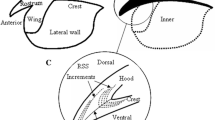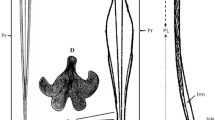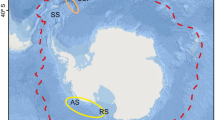Abstract
Analysis of growth increments in beak rostrum sagittal sections (RSSs) has been increasingly used for estimating octopus age. In this study, we develop an effective method to process and read the RSS of four oceanic ommastrephid squid species (Dosidicus gigas, Ommastrephes bartramii, Illex argentinus and Sthenoteuthis oualaniensis) and validate the daily deposition of the increments by comparing to corresponding statolith-determined ages. The proposed method of processing yielded readable rates ranging from 42.9 % in I. argentinus to 71.7 % in D. gigas for samples from I. argentinus to D. gigas. The high precision of the increment readings with low independent counting coefficient of variation indicates that the processing and counting methods used are reliable. This study suggests that the RSS of the upper beak is an appropriate tool for estimating the age of D. gigas, O. bartramii and perhaps S. oualaniensis, although erosion of the rostral region may result in an underestimation of squid ages.






Similar content being viewed by others
References
Arkhipkin AI (1993) Age, growth, stock structure and migratory rate of pre-spawning short-finned squid Illex argentinus based on statolith ageing investigations. Fish Res 16(4):313–338
Arkhipkin AI, Shcherbich ZN (2012) Thirty years’ progress in age determination of squid using statoliths. J Mar Biol Assoc UK 92(6):1389–1398
Bárcenas GV, Perales-Raya C, Bartolomé A, Almansa E, Rosas C (2014) Age validation in Octopus maya (Voss and Solís, 1966) by counting increments in the beak rostrum sagittal sections of known age individuals. Fish Res 152:93–97
Bettencourt V, Guerra A (2001) Age studies based on daily growth increments in statoliths and growth lamellae in cuttlebone of cultured Sepia officinalis. Mar Biol 139:327–334
Bizikov VA (1991) A new method of squid age determination using the gladius. In: Jereb P, Ragonese S, von Boletzky S (eds) Squid age determination using statoliths: proceedings of the international workshop of the Instituto di Tecnologia della Pesca e del Pescato. N.T.R.-I.T.T.P. Special Publication, 1, pp 39–51
Canali E, Ponte G, Belcari P, Rocha F, Fiorito G (2011) Evaluating age in Octopus vulgaris: estimation, validation and seasonal differences. Mar Ecol Prog Ser 441:141–149
Castanhari G, Tomás ARG (2012) Beak increment counts as a tool for growth studies of the common octopus Octopus vulgaris in Southern Brazil. Bol Inst Pesca São Paulo 38:323–331
Chen XJ, Lu HJ, Liu BL, Yong C (2011) Age, growth and population structure of jumbo flying squid, Dosidicus gigas, based on statolith microstructure off the Exclusive Economic Zone of Chilean waters. J Mar Biol Assoc UK 91(1):229–235
Chung MT, Wang CH (2013) Age validation of the growth lamellae in the cuttle bone from cultured Sepia pharaonis at different stages. J Exp Mar Biol Ecol 447:132–137
Clarke MR (1965) “Growth rings” in the beaks of the squid Moroteuthis ingens (Oegopsida: Onychoteuthidae). Malacologia 3(2):287–307
Clarke MR (1986) A handbook for the identification of cephalopod beaks. Clarendon Press, Oxford, p 273
Clarke MR (1993) Age determination and common sense—a free discussion on difficulties encountered by the author. In: Okutani T, O’Dor RK, Kubodera T (eds) Recent advances in cephalopod fisheries biology. Tokai University Press, Tokyo, pp 670–678
Clarke MR (1996) The role of cephalopods in the world’s oceans. Philos T R Soc B 351:977–1112
Csirke J (2005) Review of the state of world marine fishery resources. FAO Fisheries Technical Paper 457
Dawe EG, Natsukari Y (1991) Light microscopy. In: Jereb P, Ragonese S, von Boletzky S (eds) Squids age determinations using statoliths: proceedings of the international workshop of the Instituto di Tecnologia della Pesca e del Pescato. N.T.R.-I.T.T.P. Special Publication, vol 1, pp 83–95
Doubleday ZA, Semmens JM (2011) Quantification of the age-pigment lipofuscin in known-age octopus (Octopus pallidus): a potential tool for age determination. J Exp Mar Biol Ecol 397:8–12
Doubleday ZA, Semmens JM, Pecl G, Jackson GD (2006) Assessing the validity of stylets as ageing tools in Octopus pallidus. J Exp Mar Biol Ecol 338:35–42
Hermosilla CA, Rocha F, Fiorito G, González ÁF, Guerra Á (2010) Age validation in common octopus Octopus vulgaris using stylet increment analysis. ICES J Mar Sci 67:1458–1463
Hernández-López JL, Castro-Hernández JJ, Hernández-García V (2001) Age determined from the daily deposition of concentric rings on common octopus (Octopus vulgaris) beaks. Fish B-NOAA 99:679–684
Hurley GV, Odense PH, O’Dor RK, Dawe EG (1985) Strontium labelling for verifying daily growth increments in the statolith of the short-finned squid (Illex illecebrosus). Can J Fish Aquat Sci 42:380–383
Iglesias J, Fuentes L, Villanueva R (2014) Cephalopod culture. Springer Press, New York, p 493
Jackson GD (1994) Application and future potential of statoliths increment analysis in squids and sepioids. Can J Fish Aquat Sci 51:2612–2625
Jackson GD (2004) Advances in defining the life histories of myopsid squid. Mar Fresh Res 55:357–365
Jereb P, Roper CFE (2010) Cephalopods of the world: an annotated and illustrated catalogue of cephalopod species known to date. Myopsid and Oegopsid squids, vol 2, pp 649
Lipinski MR (1978) The age of the squid Illex illecebrosus (LeSueur, 1821) from their statoliths. ICNAF Research Document, 78/II/15
Liu BL, Chen XJ, Zhong JS (2009) Age, growth and population structure of squid Sthenoteuthis oualaniensis in northwest Indian Ocean by statolith microstructure. J Dalian Fish Univ 24:206–212
Liu BL, Chen XJ, Li JH, Fang Z (2014) Review on age and growth of cephalopod using their beaks. Chin J Shanghai Ocean Univ 23(6):930–936
Luo LQ, Wei HQ (2011) Statistics. Chinese Financial and Economic Press, Bei Jing, p 294
Mereu M, Stacca D, Cannas R, Cuccu D (2011) On the growth rings on Histioteuthis bonnellii (Férussac, 1835) upper beaks. Biol Mar Mediterr 18(1):124–127
Nakamura Y, Sakurai Y (1991) Validation of daily growth increments in statoliths of Japanese common squid Todarodes pacificus. Nippon Suisan Gakk 57:2007–2011
Oosthuizen A (2003) A development and management framework for a new Octopus vulgaris Fishery in South Africa. PhD thesis, Rhodes University, pp 183
Perales-Raya C, Hernández-González CL (1998) Growth lines within the beak microstructure of the Octopus vulgaris Cuvier, 1797. S Afr J Mar Sci 20:135–142
Perales-Raya C, Bartolomé A, García-Santamaría MT, Pascual-Alayón P, Almansa E (2010) Age estimation obtained from analysis of octopus (Octopus vulgaris Cuvier, 1797) beaks: improvements and comparisons. Fish Res 106:171–176
Perales-Raya C, Almansa E, Bartolomé A, Felipe BC, Iglesias J, Sánchez FJ, Carrasco JF, Rodríguez C (2014a) Age validation in Octopus vulgaris across the full ontogenetic range: beaks as recorders of live events in octopuses. J Shellfish Res 33(2):1–13
Perales-Raya C, Jurado-Ruzafa A, Bartolomé A, Duque V, Carrasco MN, Fraile-Nuez E (2014b) Age of spent Octopus vulgaris and stress mark analysis using beaks of wild individuals. Hydrobiologia 725:105–114
Perez JAA, O’Dor RK, Beck P, Dawe EG (1996) Evaluation of gladius dorsal surface structure for age and growth studies of the short-finned squid, Illex illecebrosus (Teuthoidea: Ommastrephidae). Can J Fish Aquat Sci 53:2837–2846
Rodríguez-Domínguez A, Rosas C, Méndez-Loeza I, Markaida U (2013) Validation of growth increments in stylet, beaks and lenses as aging tools in Octopus maya. J Exp Mar Biol Ecol 449:194–199
Sakai M, Brunetti N, Bower J, Elena B, Ichii T, Ivanovic M, Sakurai Y, Wakabayashi T, Wakabayashi T, Yatsu A (2007) Daily growth increments in upper beak of five ommastrephid paralarvae, Illex argentinus, Ommastrephes bartramii, Dosidicus gigas, Sthenoteuthis oualaniensis, Todarodes pacificus. Squids Resour Res Conf 9:1–7
Uozumi Y, Ohara H (1993) Age and growth of Nototodarus sloanii(Cephalopoda: Oegopsida) based on daily increment counts in statoliths. Nippon Suisan Gakk 59(9):1469–1477
Villanueva R (2000) Effect of temperature on statolith growth of the European squid Loligo vulgaris during early life. Mar Biol 136:449–460
Yatsu A, Midorikawa S, Shimada T, Uozumi Y (1997) Age and growth of the neon flying squid, Ommastrephes bartramii, in the North Pacific Ocean. Fish Res 29:257–270
Acknowledgments
This work was funded by National Nature Science Foundation of China (NSFC 41306127 and NSFC41276156), National Nature Science Foundation of Shanghai (No. 13ZR1419700), the Innovation Program of Shanghai Municipal Education Commission (No. 13YZ091), the Ph.D. Programs Foundation of Ministry of Education of China (No. 20133104120001) and Shanghai Universities First-class Disciplines Project (Fisheries). Y. Chen’s involvement was supported by Shanghai 1000 Talent Plan Program and SHOU International Center for Marine Sciences.
Author information
Authors and Affiliations
Corresponding author
Additional information
Communicated by G. Pierce.
Reviewed by undisclosed experts.
Rights and permissions
About this article
Cite this article
Liu, B.L., Chen, X.J., Chen, Y. et al. Determination of squid age using upper beak rostrum sections: technique improvement and comparison with the statolith. Mar Biol 162, 1685–1693 (2015). https://doi.org/10.1007/s00227-015-2702-0
Received:
Accepted:
Published:
Issue Date:
DOI: https://doi.org/10.1007/s00227-015-2702-0




